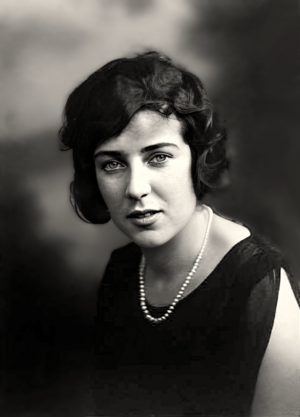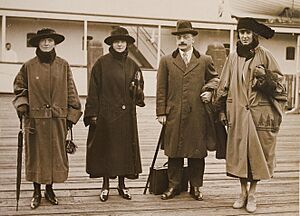Kathleen Napoli McKenna facts for kids
Quick facts for kids
Kathleen Napoli McKenna
|
|
|---|---|
 |
|
| Born |
Kathleen Maria Kenna
9 September 1897 Oldcastle, County Meath
|
| Died | 22 March 1988 (aged 90) Rome, Italy
|
| Occupation |
|
| Known for | Arthur Griffith's private secretary during the 1921 Anglo-Irish Treaty negotiations |
Kathleen Napoli McKenna (born Kathleen Maria Kenna, 9 September 1897 – 22 March 1988) was an Irish activist and journalist. She worked closely with Arthur Griffith, a key figure in Irish independence.
Contents
Growing Up in Ireland
Kathleen Maria Kenna was born on 9 September 1897 in Oldcastle, County Meath. Her parents were William and Mary Kenna. William was a shop owner. Kathleen was the oldest of seven children. As teenagers, she and her siblings added "Mc" to their last name.
Her grandfather, a Fenian (an Irish nationalist group), was a big influence on her. He was involved in land rights. Kathleen went to school in Oldcastle. She even passed the entrance exam for the National University of Ireland. She briefly attended University College Dublin. However, her family's money problems meant she couldn't finish her studies.
Her father was active in groups like the Irish National Land League and the Meath Labour Union. He helped start a local newspaper called Sinn Féin – Oldcastle Monthly Review. Both her parents were also part of the Gaelic League, which promoted the Irish language. Important Irish leaders like Arthur Griffith often visited their home.
Because of her father's political activities, his business faced problems. In 1915, the family moved to Dundalk. Then, in 1916, they moved to Rugby, Warwickshire in England. In Rugby, her father taught typing. Her mother worked in a factory making ammunition. Kathleen herself worked as a secretary for an engineering company. Some family members returned to Ireland between 1919 and 1922.
Working for Irish Independence
Kathleen often visited Ireland for holidays. In the summer of 1919, she went to the Sinn Féin offices in Dublin. She had a letter from her father to Arthur Griffith. The letter said she wanted to help Ireland become independent. During her holidays, she worked for the Sinn Féin press office. She was one of the first "dáil girls," helping the secret Irish government.
In October 1919, she was called back to Dublin. After a typing test, she joined the Irish Bulletin on 11 November. This was a newspaper run by the Irish government. She worked under Desmond FitzGerald, the minister for propaganda, and Robert Brennan. She also joined a branch of the Gaelic League.
The Irish Bulletin was published five times a week. It shared news about the British government's actions in Ireland. Kathleen helped edit and copy summaries of "acts of aggression" by British forces. These were put together by Anna Kelly. Frank Gallagher did most of the writing. Kathleen typed each issue onto a wax stencil. This stencil was then used to make many copies. These copies were sent to England. At first, about 30 people received the Bulletin. By July 1921, over 1200 people received it.
Kathleen also managed the accounts and took dictation. Sometimes, she wrote articles from notes given to her by Griffith. She also worked as a secret messenger. She carried messages between government departments and Irish Republican Army (IRA) leaders like Michael Collins.
The Bulletin became a symbol of the secret Irish government. It was a target for British forces. This meant the office had to move often to different hiding places in Dublin. Kathleen worried about being captured. Despite some staff being caught and office files seized in March 1921, the Bulletin never missed an issue.
Kathleen's sister, Winifred, also worked as a secretary for the secret government. Her brother, Tadhg, was involved in trade unions. He was arrested and held in 1921. He later became an activist for the Irish Labour Party. Her brother William was a messenger for the Irish government. During the Irish Civil War, he served in the Free State Army.
After a truce in 1921, Kathleen worked for the Dáil cabinet at the Mansion House. She continued in the publicity department. In October 1921, she traveled to London as Arthur Griffith's private secretary. This was for the negotiations of the Anglo-Irish Treaty. She admired both Griffith and Collins. She strongly supported the Anglo-Irish Treaty. She worked for Griffith until just before he died. She also did some secretarial work for Collins during the talks. Her support for the treaty caused her to lose some friends.
When the Irish Free State government was set up, Kathleen became a private secretary. She worked for several ministers for external affairs. These included FitzGerald, Kevin O'Higgins, and W. T. Cosgrave. In 1924, she was a private secretary for the boundary commission. She also traveled with the Irish team to a conference in London. From 1927 to 1931, she was a secretary for James Dolan. Before it closed in 1924, she wrote articles for the Freeman's Journal newspaper.
Life in Italy
In 1931, Kathleen married Vittorio Napoli. He was a captain in the Italian royal grenadier guards. They had met in Italy in 1927. For the first five years of their marriage, they lived in Derna, Libya. Her husband was stationed there. Their son and daughter were born there.
From 1939 to 1940, the family lived in Albania. But after Italy joined World War II, Kathleen and her children moved to Viterbo, Italy. Her husband was captured in Greece in 1943. He was held in Germany and Poland. He returned to Italy in 1945. Viterbo had been heavily bombed. After Allied troops arrived, Kathleen worked as a translator. She also gave English lessons to support her family. Her husband stayed in the army. They lived in Viterbo until 1956, then moved to Rome.
After the war, Kathleen wrote articles for many newspapers and magazines. These included the Irish Independent, The Irish Press, and Writer's Digest. She wrote under her own name and also used pen names like Kayn or Kayen MacKay. Wives of Italian officers usually did not work. So, the money she earned was used for travel and fun activities. This money allowed her to visit Ireland in 1947. It was her first visit since 1932. After they retired, Kathleen and her husband visited Ireland regularly. They also traveled around Italy.
Later Years and Legacy
Kathleen applied for an Irish military pension in 1950 and 1970. However, her claims were turned down. This was because she had not served in a military group. As someone who helped during the War of Independence, she was given free travel in 1972. This was later extended to her husband.
In her later years, Kathleen became worried about mistakes in the history of the War of Independence and the Civil War. In 1951, she gave two talks on Radio Éireann. She spoke about her time with the Irish Bulletin. Copies of these talks are now kept at the Bureau of Military History. Parts of her own memories were published in the Capuchin Annual and The Irish Times. She wrote and rewrote her memories from the late 1940s to the early 1980s. A version edited by her daughter and niece was published in 2014. It was called A dáil girl's revolutionary recollections.
Kathleen McKenna died on 22 March 1988 in Rome. She was buried with an Irish flag that she had kept. A large collection of her papers is held in the National Library of Ireland. Some of her personal items were sold in Dublin in 2010, 2011, and 2016.
Images for kids




